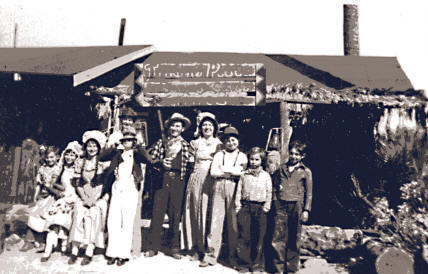|
|
||
 |
||
|
Thousand Palms History |
||
|
|
|
|
|
THOUSAND PALMS: THE
YESTERYEARS |
||
|
In 1912, Route 99 was built and became the main route from Los Angeles and San Bernardino to the east. It passed within 100 feet of the date gardens, thereby deepening an economic rivalry that had arisen between the citrus and date ranch settlements. The area was profitable for the ranches because water was at hand from local ground wells as well as from the spring at Thousand Palms Canyon, six miles to the north. The railroad provided access to outside markets, and the construction of Route 99 made this area appealing to developers. When buyers failed to materialize for a large residential project, however, the momentum stalled. Despite the setback, Edom continued to grow around the dual centers of Strelows’ “crossroads” and McKesson’s citrus ranch, later purchased by James Kubic. When it came to buying supplies, the settlers became geographically dependent on their respective settlements, so to entice new business each community attempted to become a superior economic draw. When a post office was contemplated, each fought to have it closer to their settlement and eventually there was animosity. In the early 1930s, the rivalry reached its peak when deciding to find a permanent location for a schoolhouse. Della Lindley had started a school in a railroad boxcar on her husband’s homestead, but when it came time to expand and build a new schoolhouse, Kubic donated two acres of land to the school district and the school was built near the citrus ranch. A few years later when a bigger school needed to be built, the rivalry caused the Riverside County Superintendent to put the location to a public vote. On Election Day certain “crossroads” supporters arrived wearing gun belts and revolvers, and when told to go home and put their firearms away, some didn’t return. That made it a close election, and it was Della Lindley who actually cast the deciding vote. The new school was built next to the tamarisk-tree shaded boxcar on her husband’s property. The school had brought pride to the community though, and ultimately it aided in bringing both centers together in spirit. Lindley’s special teaching methods helped a large majority of her students win national honors for high scholarship, oratory, essays and plays. Many of the students went on to graduate from universities, an outstanding achievement for a little country school. Soon after the elections the first “community-wide” dance was held. Edom Becomes a Village In 1942, a dirt and gravel road was cut between Palm Springs and Edom; it was later named Ramon Road. In 1945 the community began to take shape as travelers on Highway 99 supported restaurants, motels, service stations and local produce shops. New social institutions were started. A riding club was formed. Saturday night dances were held at Desert Moon Guest Ranch, home of the Hyde sisters. In 1946 a Sunday school began that later grew into a community church. The village continued to blossom until 1957 when Interstate 10 was built between Highway 99 and the railroad tracks. The freeway bypassed the existing businesses on the old highway (now called Varner Road) and the streets accessing Edom were dangerous to navigate. The Chamber of Commerce fought for proper access bridges, and in 1962 the overpass was built at Ramon and Interstate 10, but in the intervening years the once thriving roadside businesses had deteriorated. Developers hadn’t given up on the area though. Since the beginning, they had seen the central Coachella Valley location as an attraction for permanent and seasonal residential development. In fact, just after World War II visionary developer Charley Doyle had already begun subdividing about 1,500 acres of desert land on Ramon Road, three miles east of the highway. He extended an existing well and tapped into an “underground hot water vein from the nearby San Andreas fault.” After establishing the water supply, he and the Hyde sisters and other old-timers prevailed on the postmaster to change the name of the area from Edom, which they felt connoted wicked images of Esau selling his birthright for a hot meal, to Thousand Palms as it was already unofficially known. In 1957, The United Parcel Service opened a station in Thousand Palms because of its central Valley location and easy access to the surrounding areas. In 1963 an ore reduction plant, a concrete plant and a bus garage located in the same area. By the end of the 1960s Thousand Palms had changed from a roadside town to a centrally located residential and small industrial community. Prosperity was not to continue at a happy pace, however. The economic recession of the 1970s stifled growth substantially. The local residents began to seek employment and services in neighboring towns. Retail development almost ceased. By the beginning of the 1980s Thousand Palms sense of “community” was almost non-existent. Over the last 20 years, thanks to a small core of dedicated citizens and the foresight of the business community, the will of this town to survive has been rekindled. In 2007, developers are renewing the residential areas and Thousand Palms is becoming the new frontier for those seeking a high quality lifestyle. While maintaining the freedom of its rural roots, Thousand Palms is seeing horse stables sprout up next to multi-million-dollar estates. A new community center features a beautiful library and park. And, the proud Della Lindley School, a newer version of the schoolhouse of old, celebrates the work of a pioneer schoolteacher who brought two settlements together and started the community now known as Thousand Palms. Local Historical
Tales by Bob Spence |
||
|
Sponsored by the
|
||
